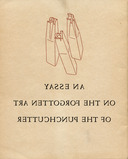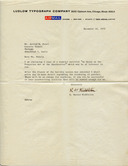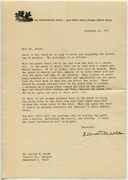See also Middleton's books Chicago Letter Founding and Making Printers' Typefaces .
In this present essay, Middleton makes only one error of substance. He says that "before the invention of the engraving machine [circa 1885] all type design was finalized by the hand of the punchcutter n the medium of soft steel, hardened and driven into copper to produce the matrix needed for typecasting." This overlooks the even more deeply forgotten art of the electroforming of matrices. This was done not only to duplicate existing types, but also to create matrices for new types from originals cut, typically, in typemetal. Many of the typefaces of the Nineteenth Century, especially the more elaborate ones, were created in this way. Indeed, the first use Benton envisioned for his engraving machine was the machine cutting of such typemetal pattern types for electroforming.
Yet this oversight does not detract from the utility of this essay. It is especially valuable because it documents the methods of a particular Twentieth Century punchcutter, Victor Hammer. The reader should bear this in mind when Middleton makes statements to the effect that things are or are not done in a particular way. This essay gives Victor Hammer's way. Middleton was better than most at avoiding the trap of asserting that the one way he was told about was the only way, but the methods of making type seem to have encompassed every possible way.

An Essay ...
The bibliographical citation of this work is particularly difficult. It has no title page. The only information about it comes from a colophon, which says that it was produced as a keepsake for "a talk on the subject of Punchcutting given before the students and staff members of the School of Library Service of the University of California, Los Angeles, by R. Hunter Middleton on March 31, 1965." Presumably it was printed by the School; the fact that the cover drawing is in error and that this error went to press suggests that Middleton did not print it himself.
The icon above left links to a presentation of this book at The Internet Archive, where it may be read online or downloaded. Here is a local copy of the PDF (259 Megabytes): middleton-an-essay-on-the-forgotten-art-of-the-punchcutter-1965-0600dpijpg.pdf

Middleton to Patel (1970)
My copy of this work is one which was given by R. Hunter Middleton to Arvind M. Patel, of India. Mr. Patel (d. 2010) was the son of the founder of the India Type Company in Ahmedabad. He had, apparently, queried Middleton on the subject of punchcutting. Here is the letter that accompanied the presentation of this volume.

Middleton to Patel (1971)
Middleton did follow up on his promise to discuss the details of hardening and tempering punches. The method described is familiar to blacksmiths as the most elegant way to harden and temper a tool (accomplishing both processes in a single heat). The Cherryburn Press was Middleton's private press.
Middleton's Essay... was published in the US without copyright notice at a time when such notice was required to secure copyright. It therefore passed into the public domain upon initial publication. The digital reprint of it here remains in the public domain.
The two letters by Middleton to Patel were unpublished, and therefore are now in copyright. Presumably that copyright is owned by Middleton's literary estate. I own the original documents, however, and given their significance for the history of punchcutting feel justified in presenting them here. Please note, however, that they are neither in the public domain nor copyright by me. They are not licensed under the same Creative Commons license as the rest of this page, and should not be reproduced further without appropriate permission.
All portions of this document not noted otherwise are Copyright © 2011, 2024 by David M. MacMillan.
Circuitous Root is a Registered Trademark of David M. MacMillan.
This work is licensed under the Creative Commons "Attribution - ShareAlike" license, version 4.0 International. See http://creativecommons.org/licenses/by-sa/4.0/ for its terms.
Presented originally by Circuitous Root®